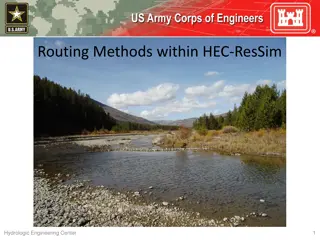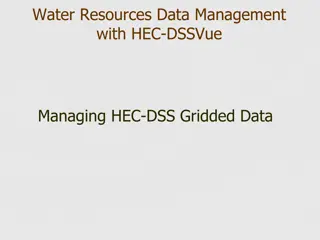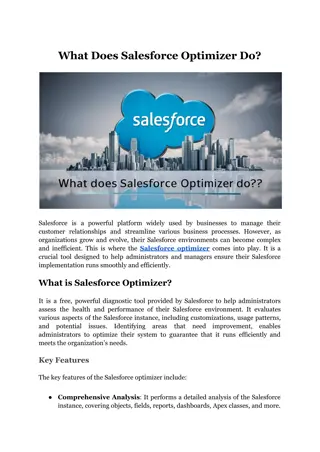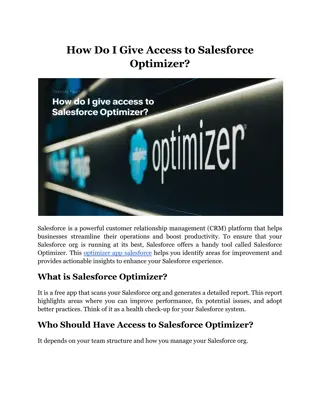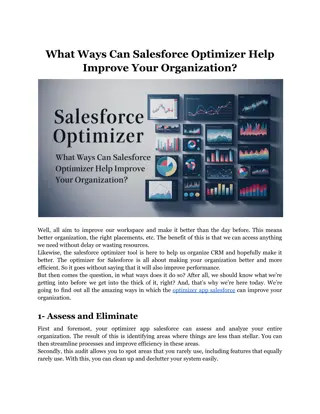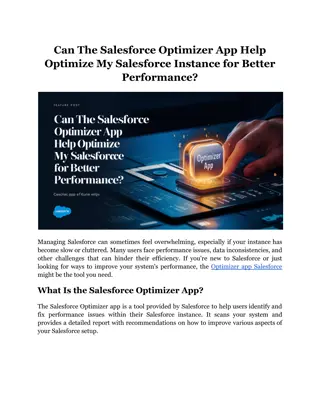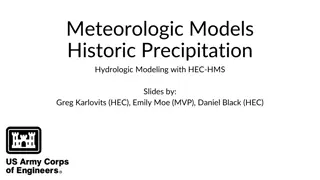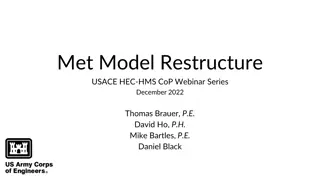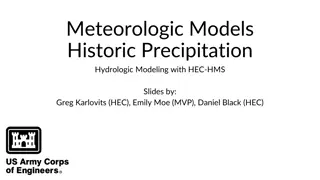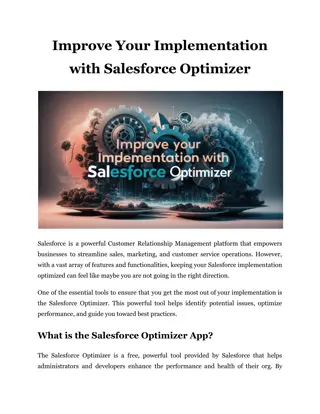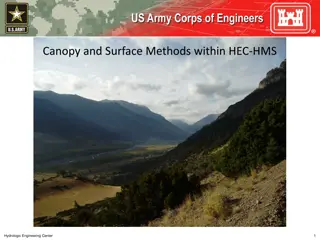
Automated Floodway Optimization for HEC-RAS
This research focuses on developing an automated floodway optimizer for HEC-RAS to determine the minimal area required to convey a 100-year flow without causing excessive flooding. The current manual process of finding encroachment limits is tedious and time-consuming. The proposed solution involves using ISPSO optimization technique with a command-line interface to automate the search for encroachment limits, removing human biases and reducing repetitive work. The advantages of automation include consistent procedures and minimizing footprint area.
Uploaded on | 0 Views
Download Presentation

Please find below an Image/Link to download the presentation.
The content on the website is provided AS IS for your information and personal use only. It may not be sold, licensed, or shared on other websites without obtaining consent from the author. If you encounter any issues during the download, it is possible that the publisher has removed the file from their server.
You are allowed to download the files provided on this website for personal or commercial use, subject to the condition that they are used lawfully. All files are the property of their respective owners.
The content on the website is provided AS IS for your information and personal use only. It may not be sold, licensed, or shared on other websites without obtaining consent from the author.
E N D
Presentation Transcript
TOWARDS AN AUTOMATED FLOODWAY OPTIMIZER FOR HEC-RAS By: Tien Yee & Huidae Cho
FLOODWAY Minimal area required to effectively convey 100-yr flow without causing excessive(1ft rise) flooding. Defined by encroachment limits Floodway boundaries are important Public safety, Development, Regulatory & permitting Economic Etc.
FLOODWAY CRITERIA Typical encroachment limits - Within 100-yr floodplain Surcharge < 0.3 m (1ft), positive Subcritical (FR<1) for most streams Standard software accepted FEMA HEC-RAS Difficult to customize code
THE ISSUE Finding encroachment limits is Tedious and time consuming Can be established in many different ways - inconsistent - modeler dependent Sometimes, may be biased
PROPOSED SOLUTION HEC-RAS Encroachment limits Hydraulic Output Automate AFORAS Automated Floodway Optimizer for HEC-RAS Command line interface with HEC-RAS (CLIRAS) Main Program Main Program (AFORAS) Encroachment limits Objective Function value CLIRAS Command Line Interface communication Updated Optimization Optimization (ISPSO) provides target
OPTIMIZATION Made it possible - Automate search for encroachment limits Optimization technique ISPSO Isolated Speciation based Particle Swarm Optimization Objective function ??? ???????? ?( ?, ?) = ???_????? Where, Afw = Ai Amin = Current floodway Area Afw_range= Amax Amin = Max Possible Floodway Area No user intervention necessary
OPTIMIZATION FLOW CHART Optimization Model Initialize Evaluate Evolve Input 3 Input 2 Input n Input 1 CLIRAS HEC-RAS Output 1 Output 2 Output 3 Output n
ADVANTAGES OF AUTOMATION Advantage Consistent procedure Remove human biases Avoid tedious/repetitive work Minimize footprint area
TEST CASES Fixed Total Cross Sections Total structures Reach name Encroachment Boundary Two models were tested 1. Prairie Brooke Helena, Alabama Pairie Brook 21 4 DS Acton Creek 43 3 None 2. Acton Creek Birmingham, Alabama Test cases chosen Contain Effective floodways Publicly Accessible - Free download (http://fris.nc.gov/fris/Home.aspx?ST=AL)
Prairie Brook Acton Creek
Optimized Floodway Model Effective Floodway Model River Station (m) PRAIRIE BROOK Surcharge (m) Froude Number Surcharge (m) Froude Number 2,314 2,168 2,081 1,925 1,741 1,572 1,428 1,308 1,129 1,103 1,086 1,065 1,041 878 752 739 573 276 200 134 66 0.15 0.21 0.30 0.21 0.30 0.27 0.21 0.31 0.31 0.31 0.31 0.29 0.30 0.30 0.30 0.30 0.30 0.30 0.30 0.01 0.08 0.04 0.15 0.27 0.29 0.28 0.26 0.18 0.30 0.29 0.29 0.29 0.29 0.30 0.28 0.27 0.26 0.26 0.24 0.25 0.09 0.08 0.99 0.30 0.44 0.22 0.56 0.28 0.52 0.14 0.06 0.08 0.08 0.18 0.12 0.09 0.08 0.10 0.04 0.10 0.07 0.70 0.33 0.83 0.29 0.47 0.27 0.45 0.32 0.48 0.14 0.05 0.05 0.09 0.22 0.14 0.06 0.06 0.05 0.04 0.03 0.07 1.11 0.33 Comparing surcharge and Froude Number Culvert
Optimized Floodway Model Effective Floodway Model ACTON CREEK Surcharge (m) Froude Number Surcharge (m) Froude Number River Station (m) 5,130 Comparing surcharge and Froude number 0.24 0.44 0.21 0.37 4,962 0.12 0.54 0.15 0.51 4,807 0.15 0.44 0.15 0.46 4,747 0.20 0.40 0.05 0.54 4,591 0.30 0.51 0.08 0.57 0.30 0.50 4,523 0.15 0.53 4,297 0.27 0.60 0.20 0.64 4,148 0.30 0.38 0.16 0.41 3,999 0.09 0.57 0.15 0.42 3,984 0.21 0.60 0.16 0.45 3,850 0.26 0.55 0.07 0.64 0.27 0.62 3,684 0.20 0.57 Bridge 0.30 0.51 3,569 0.09 0.57 Culvert 3,399 0.17 0.54 0.02 0.51 3,279 0.16 0.41 0.01 0.40 3,112 0.02 0.35 0.00 0.27 3,023 0.01 0.35 0.01 0.31
Bridge Culvert
RESULTS SUMMARY Promising results Footprint area smaller than effective models Objective Function Value Reach Name Effective Model 0.224 0.418 Optimized Model 0.165 0.372 Prairie Brook Acton Creek Meets all constraints
LIMITATIONS Model not perfect Undulated floodway Computation time Try other optimization techniques Cannot handle mixed or supercritical flows
CONCLUSIONS Model is still under development still needing many improvements Model is capable of Automate & minimize floodway footprint If you have any HEC-RAS models for testing, please do not hesitate to contact me tyee@kennesaw.edu
THANK YOU. Questions?
INTERESTED PARTIES FEMA safety and flood control reasons City planners Economic and Safety reasons Private Landowners Economic and safety Etc.




